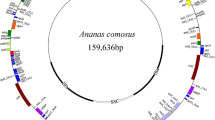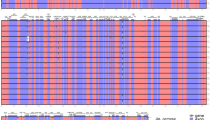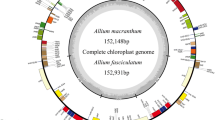Abstract
Chloroplast simple sequence repeats (cpSSRs) are widely distributed in the chloroplast genomes of all plant species, and are frequently employed for genotypic and phylogenetic analysis. However, information on intra- and interspecies variation in cpSSRs is lacking. In this study, we sequenced four intergenic (non-coding) chloroplast DNA regions in 57 accessions of 12 tetraploid, and 16 accessions of 4 hexaploid species of Triticum and Aegilops. These sequence data added to our previous data for diploid species in the same chloroplast regions. Intra- and interspecific genetic variation was analyzed for a total of 189 accessions of 13 diploid, 12 tetraploid, and 4 hexaploid species of Triticum and Aegilops, such that all species were represented by multiple accessions. The data were used to infer phylogenetic relationships within and among Triticum and Aegilops species. Based on this robust phylogenetic tree, seven of eight cpSSR loci clearly exhibited “size homoplasy,” referring to the fact that cpSSRs of identical size and DNA sequence can arise even if the alleles are not descended from a common ancestor. These data indicate that cpSSRs should be used with caution in phylogenetic analyzes. Interestingly, as observed from several previous studies, our data also suggest that observed mutation rates may increase significantly when mononucleotide (homopolymer) repeat numbers reach or exceed 9 bp. In the present report, using this sequence data set involving cpSSRs, 81 unique haplotypes among 189 accessions were detected, and five tetraploid Triticum and Aegilops species were successfully identified and genotyped. Our results indicate that combinations of nucleotide substitutions, indels and SSRs of chloroplast nucleotide sequences are available for genoty** at the species accession level.




Similar content being viewed by others
References
Ananda G, Walsh E, Jacob KD, Krasilnikova M, Eckert KA, Chiaromonte F, Makova KD (2013) Distinct mutational behaviors differentiate short tandem repeats from microsatellites in the human genome. Genome Biol Evol 5:606–620
Bryan GJ, McNicoll J, Ramsay G, Meyer RC, De Jong WS (1999) Polymorphic simple sequence repeat markers in chloroplast genomes of Solanaceous plants. Theor Appl Genet 99:859–867
Clegg MT (1993) Chloroplast gene sequences and the study of plant evolution. Proc Natl Acad Sci USA 90:363–367
Dechering KJ, Cuelenaere K, Konings RN, Leunissen JA (1998) Distinct frequency-distributions of homopolymeric DNA tracts in different genomes. Nucleic Acids Res 26:4056–4062
Deng Z, La Malfa S, **e Y, **ong X, Gentile A (2007) Identification and evaluation of chloroplast uni- and trinucleotide sequence repeats in citrus. Sci Hortic 111:186–192
Doyle JJ, Morgante M, Tingey SV, Powell W (1998) Size homoplasy in chloroplast Microsatellites of wild perennial relatives of soybean (Glycine subgenus Glycine). Mol Biol Evol 15:215–218
Ebert D, Peakall R (2009) Chloroplast simple sequence repeats (cpSSRs): technical resources and recommendations for expanding cpSSR discovery and applications to a wide array of plant species. Mol Ecol Resour 9:673–690
Ellegren H (2004) Microsatellites: simple sequences with complex evolution. Nat Rev Genet 5:435–445
Estoup A, Tailliez C, Cornuet JM, Solignac M (1995) Size homoplasy and mutational processes of interrupted microsatellites in two bee species, Apis mellifera and Bombus terrestris (Apidae). Mol Biol Evol 12:1074–1084
Farris JS (1989) The retention index and the rescaled consistency index. Cladistics 5:417–419
Felsenstein J (1985) Confidence limits on phylogenies: an approach using the bootstrap. Evolution 39:783–791
Fondon JW, Martin A, Richards S, Gibbs RA, Mittelman D (2012) Analysis of microsatellite variation in Drosophila melanogaster with population-scale genome sequencing. PLoS ONE 7:e33036
Garza JC, Slatkin A, Freimer NB (1995) Microsatellite allele frequencies in humans and chimpanzees, with implications for constraints on allele size. Mol Biol Evol 12:594–603
Guichoux E, Lagache L, Wagner S, Chaumeil P, Léger P, Lepais O, Lepoittevin C, Malausa T, Revardel E, Salin F, Petit RJ (2011) Current trends in microsatellite genoty**. Mol Ecol Resour 11:591–611
Hale ML, Borland AM, Gustafsson MHG, Wolff K (2004) Causes of size homoplasy among chloroplast microsatellites in closely related Clusia species. J Mol Evol 58:182–190
Ishii T, Mori N, Ogihara Y (2001) Evaluation of allelic diversity at chloroplast microsatellite loci among common wheat and its ancestral species. Theor Appl Genet 103:896–904
Jakobsson M, Sall T, Lind-Halldén C, Halldén C (2007) Evolution of chloroplast mononucleotide microsatellites in Arabidopsis thaliana. Theor Appl Genet 114:223–235
Kadosumi S, Kawahara T, Sasanuma T (2005) Multiple origins of Ugenome in two UM genome tetraploid Aegilops species, Ae. columnaris and Ae. triaristata, revealed based on the polymorphism of a genome-specific PCR fragment. Genes Genet Syst 80:105–111
Kawahara T (1997) Catalogue of Aegilops-Triticum germ-plasm preserved in Kyoto University 2. Kyoto University, Kyoto, Japan, Laboratory of Crop Evolution
Kawahara T (1998) Catalogue of Aegilops-Triticum germ-plasm preserved in Kyoto University 2, supplement. Laboratory of Crop Evolution, Kyoto University, Kyoto
Kelchner SA (2000) The evolution of non-coding chloroplast DNA and its application in plant systematics. Ann Mo Bot Gard 87:482–498
Kelkar YD, Strubczewski N, Hile SE, Chiaromonte F, Eckert KA, Makova KD (2010) What is a microsatellite: a computational and experimental definition based upon repeat mutational behavior at A/T and GT/AC repeats. Genome Biol Evol 2:620–635
Kihara H (1954) Consideration on the evolution and distribution of Aegilops species based on the analyser-method. Cytologia 19:336–357
Kimber G, Tsunewaki K (1988) Genome symbols and plasma types in the wheat group. In: Proceedings of 8th international wheat genetics symposium, Cambridge, pp 1209–1210
Kimura M (1980) A simple method for estimating evolutionary rates of base substitutions through comparative studies of nucleotide sequences. J Mol Evol 16:111–120
Kluge AG, Farris JS (1969) Quantitative phyletics and the evolution of anurans. Syst Zool 18:1–32
Lai Y, Sun F (2003) The relationship between microsatellite slippage mutation rate and the number of repeat units. Mol Biol Evol 20:2123–2131
Liu K, Muse SV (2005) PowerMarker: integrated analysis environment for genetic marker data. Bioinformatics 21:2128–2129
Meimberg H, Rice KJ, Milan NF, Njoku CC, McKay JK (2009) Multiple origins promote the ecological amplitude of allopolyploid Aegilops (Poaceae). Am J Bot 96:1262–1273
Middleton CP, Senerchia N, Stein N, Akhunov ED, Keller B, Wicker T, Kilian B (2014) Sequencing of chloroplast genomes from wheat, barley, rye and their relatives provides a detailed insight into the evolution of the Triticeae tribe. PLoS ONE 9:e85761
Miller JR, Koren S, Sutton G (2010) Assembly algorithms for next-generation sequencing data. Genomics 95:315–327
Mori N, Kondo Y, Ishii T, Kawahara T, Valkoun J, Nakamura C (2009) Genetic diversity and origin of timopheevi wheat inferred by chloroplast DNA fingerprinting. Breed Sci 59:571–578
Navascués M, Emerson BC (2005) Chloroplast microsatellites: measures of genetic diversity and the effect of homoplasy. Mol Ecol 14:1333–1341
Newton AC, Allnutt TR, Gillies ACM, Lowe AJ, Ennos RA (1999) Molecular phylogeography, intraspecific variation and the conservation of tree species. Trends Ecol Evol 14:140–145
Nishikawa T, Vaughan DA, Kadowaki K (2005) Phylogenetic analysis of Oryza species, based on simple sequence repeats and their flanking nucleotide sequences from the mitochondrial and chloroplast genomes. Theor Appl Genet 110:696–705
Ogihara Y, Tsunewaki K (1988) Diversity and evolution of chloroplast DNA in Triticum and Aegilops as revealed by restriction fragment analysis. Theor Appl Genet 76:321–332
Ogihara Y, Isono K, Kojima T, Endo A, Hanaoka M, Shiina T, Terachi T, Utsugi S, Murata M, Mon N, Takumi S, Ikeo K, Gojobori T, Murai R, Murai K, Matsuoka Y, Ohnishi Y, Tajiri H, Tsunewaki K (2002) Structural features of a wheat plastome as revealed by complete sequencing of chloroplast DNA. Mol Genet Genom 266:740–746
Olmstead RG, Palmer JD (1994) Chloroplast DNA systematics: a review of methods and data analysis. Am J Bot 81:1205–1224
Petit RJ, Deguilloux MF, Chat J, Grivet D, Garnier-Géré P, Vendramini GG (2005) Standardizing for microsatellite length in comparisons of genetic diversity. Mol Ecol 14:885–890
Powell W, Morgante M, McDevitt R, Vendramin GG, Rafalski JA (1995) Polymorphic simple sequence repeat regions in chloroplast genomes: applications to the population genetics of pines. Proc Natl Acad Sci USA 92:7759–7763
Provan J, Powell W, Hollingsworth PM (2001) Chloroplast microsatellites: new tools for studies in plant ecology and evolution. Trends Ecol Evol 16:142–147
Qin Z, Wang Y, Wang Q, Li A, Hou F, Zhang L (2015) Evolution analysis of simple sequence repeats in plant genome. PLoS ONE 10:0144108
Saitou N, Nei M (1987) The neighbor-joining method: a new method for reconstructing phylogenetic trees. Mol Biol Evol 4:406–425
Shaw J, Lickey EB, Beck JT, Farmer SB, Liu W, Miller J, Siripun KC, Winder CT, Schilling EE, Small RL (2005) The tortoise and the hare II: relative utility of 21 noncoding chloroplast DNA sequences for phylogenetic analysis. Am J Bot 92:142–166
Shaw J, Lickey EB, Schilling EE, Small RL (2007) Comparison of whole chloroplast genome sequences to choose noncoding regions for phylogenetic studies in angiosperms: the Tortoise and the hare III. Am J Bot 94:275–288
Shaw J, Shafer HL, Rayne Leonard O, Kovach MJ, Schorr M, Morris AB (2014) Chloroplast DNA sequence utility for the lowest phylogenetic and phylogeographic inferences in angiosperms: the tortoise and the hare IV. Am J Bot 101:1987–2004
Subramanian S, Mishra RK, Singh L (2003) Genome-wide analysis of microsatellite repeats in humans: their abundance and density in specific genomic regions. Genome Biol 4:R13
Swofford DL (2002) PAUP*: phylogenetic analysis using parsimony (* and other methods), version 4.0 b10. Sinauer, Sunderland, Massachusetts, USA
Teoh SB, Hutchinson J (1983) Interspecific variation in C-banded chromosomes of diploid Aegilops species. Theor Appl Genet 65:31–40
Terachi T, Tsunewaki K (1992) The molecular basis of genetic diversity among cytoplasms of Triticum and Aegilops. VIII. Mitochondrial RFLP analysis using cloned genes as probes. Mol Biol Evol 9:917–931
Treangen TJ, Salzberg SL (2012) Repetitive DNA and next-generation sequencing: computational challenges and solutions. Nat Rev Genet 13:36–46
Tsunewaki K, Ogihara Y (1983) The molecular basis of genetic diversity among cytoplasms of Triticum and Aegilops species. II. On the origin of polyploid wheat cytoplasms as suggested by chloroplast and restriction fragment patterns. Genetics 104:155–171
Tsunewaki K, Mukai Y, Endo T (1976) Genetic diversity of the cytoplasm in Triticum and Aegilops. V. Classification of 23 cytoplasms into eight plasma type. Jpn J Genet 51:175–181
Vachon N, Freeland JR (2011) Phylogeographic inferences from chloroplast DNA: quantifying the effects of mutations in repetitive and non-repetitive sequences. Mol Ecol Resour 11:279–285
Van Slageren MW (1994) Wild wheats: a monograph of Aegilops L. and Amblyopyrum (Jaub. & Spach) Eig (Poaceae). Joint publication of ICARDA, Aleppo, Syria and Wageningen Agricultural University, The Netherlands
Wheeler GL, Dorman HE, Buchanan A, Challagundla L, Wallace LE (2014) A review of the prevalence, utility, and caveats of using chloroplast simple sequence repeats for studies of plant biology. Appl Plant Sci 2:1–12
Yamane K, Kawahara T (2005) Intra- and interspecific phylogenetic relationships among diploid Triticum-Aegilops species (Poaceae) based on base-pair substitutions, indels, and microsatellites in chloroplast noncoding sequences. Am J Bot 92:1887–1898
Zhao J, Bacolla A, Wang G, Vasquez KM (2010) Non-B DNA structure-induced genetic instability and evolution. Cell Mol Life Sci 67:43–62
Acknowledgements
We are also grateful to K. Kobayashi, Gifu University, for her essential support. We also thank M. Sumi, Gifu University, and H. Uto, Osaka Prefectural University for their support. This research was partly supported by a grant from the Ministry of Culture, Education and Technology, the National BioResource Project KOMUGI.
Author information
Authors and Affiliations
Corresponding author
Ethics declarations
Conflict of interest
All authors declare that they have no conflict of interest.
Ethical standard
The authors declare that this manuscript has been prepared according to the ethical standards as formulated by Genetic Resources and Crop Evolution.
Electronic supplementary material
Below is the link to the electronic supplementary material.
Rights and permissions
About this article
Cite this article
Yamane, K., Kawahara, T. Size homoplasy and mutational behavior of chloroplast simple sequence repeats (cpSSRs) inferred from intra- and interspecific variations in four chloroplast regions of diploid and polyploid Triticum and Aegilops species. Genet Resour Crop Evol 65, 727–743 (2018). https://doi.org/10.1007/s10722-017-0567-4
Received:
Accepted:
Published:
Issue Date:
DOI: https://doi.org/10.1007/s10722-017-0567-4




